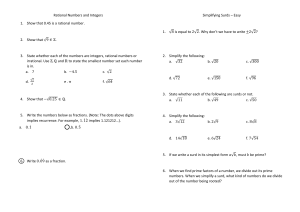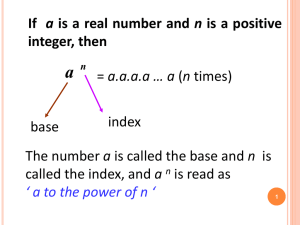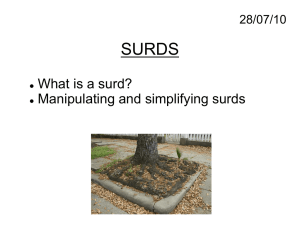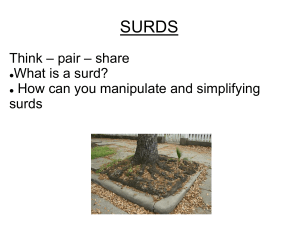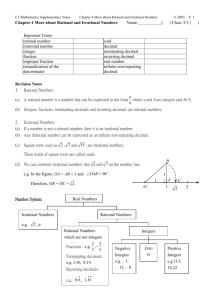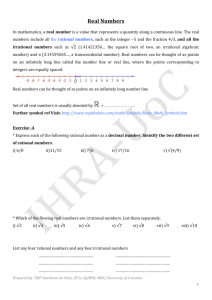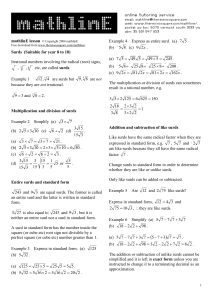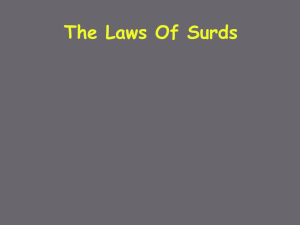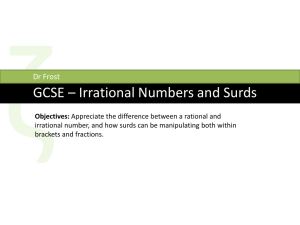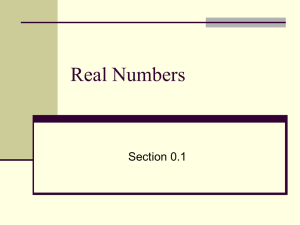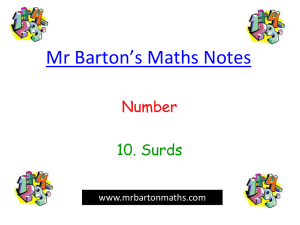Document
advertisement
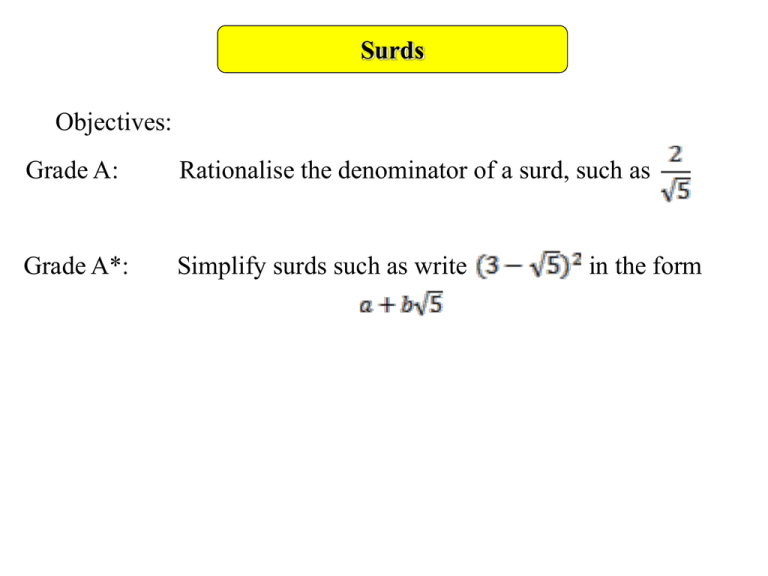
Surds Objectives: Grade A: Rationalise the denominator of a surd, such as Grade A*: Simplify surds such as write in the form Surds Prior knowledge: 1. 2. 3. 4. 5. 6. 7. 8. 52 152 132 112 92 √144 √196 √49 Identify factors that are square numbers: 25 225 169 121 81 12 14 7 1. 2. 3. 4. 5. 6. 7. 8. 20 32 500 45 72 18 98 80 4×5 16 × 2 100 × 5 9×5 36 × 2 9×2 49 × 2 16 × 5 Surds Rational number a rational number is a number which can be expressed as a ratio of two integers. Such that Where a and b are integers e.g. = Irrational number an irrational number is a number that is not an integer and cannot be expressed as a fraction. e.g. , , ,π Surd a surd is a number containing an irrational root, e.g. or 3 + 2 Surds Why use surds? To write an irrational number in surd form is to write it accurately. e.g. π is an irrational number, it has an infinite number of decimal places if you were to write it on paper as digits, at some point you would have to round it and then it would stop being completely accurate. We can find out whether a number is rational or irrational by simplifying it as far as possible. If we have simplified as far as possible and we are left with a number such as a square root of a number that is not a natural square number or a value such as π then we can determine that the number is irrational Surds Example: Are these numbers rational or irrational? √5 irrational – because it cannot be simplified to an integer √ 36 π 2 π 2π rational – because it can be simplified to an integer √ 36 = 6 irrational – because π is irrational rational – because it can be simplified to 1 2 Surds When simplifying surds it is useful to know the following √4 = 2 2×2=4 therefore and Also because 4 = √ 16 √4 × √4 = 4 √2 × √2 = 2 √ 4 × √ 4 = √ 16 Rule 1 √ a × √ b = √ ab Example: Simplify √ 98 Firstly we will look for factors of 98 that are square numbers 49 × 2 = 98 so √ 98 can be written as √ 49 × 2 Using the rule √ 49 × √ 2 =7√ 2 Surds Simplify these: 1. √ 20 √4 × 5 =√ 4 ×√ 5 = 2√ 5 2. √ 32 √ 16 × 2 =√ 16 ×√ 2 = 4√ 2 3. √500 √ 100 × 5 = √ 100 ×√ 5 = 10√ 5 4. √ 45 √9 × 5 5. √ 72 √ 36 × 2 =√ 36 ×√ 2 = 6√ 2 6. √ 18 √9 × 2 =√ 9 × √ 5 = 3√ 5 =√ 9 × √ 2 = 3√ 2 Surds Rule 2 a √b Example: Simplify √a = √b 96 √ 96 = √3 √ 3 using rule 2 Find factor(s) of 96 that are square numbers = 6 = 2 × 3 so √16×6 √3 √6 = √2 × √3 so 4 ×√ 6 √3 4 ×√ 6 √16 ×√ 6 = = √3 √3 Rule √ a × √ b = √ ab 4 ×√ 2×√ 3 = √3 =4√ 2 Surds Simplify these: 1. 40 √ 5 =√ 8 2. 81 √ 16 √ 81 = √ 16 3. 45 √ 20 9 √4 √9 = √4 4. 72 √ 16 9 √2 = √ 4 × 2 =√ 4 ×√ 2 = 2√ 2 = 9 = 21 4 4 √9 √2 = 3 = 11 2 2 =3 √2 Surds Simplify these: 5. 6 √10 = 3 ×√ 10 =3 ×√ 2×√ 5 2√5 √5 √5 6. 8 √30 4 √5 7. √ 7×√ 3 2 √21 = 4 √3 8 √3 8. 2 √10 10√ 2 = 3√ 2 2 ×√ 30 =2 ×√ 6×√ 5 = 2 ×√ 2×√ 3 = √5 √5 = √10 5 √2 √7 = 4 √ 2×√ 5 = 5 √2 √5 = 5 = 2√ 2 √ 3 Surds Rule 3 a √ c + b√ c = (a + b)√ c Example: Simplify 3 √ 2 + √ 32 = 3 √ 2 + √ 16 × 2 = 3 √ 2 + √ 16 ×√ 2 = 3√2 + 4 √2 = 7√ 2 Surds Simplify these: 1. 3√2 + √2 = 4√ 2 2. 3 √ 5 - 2√ 5 = √5 3. √ 20 +√ 5 4. 3 √ 7 - √ 28 = 3√ 7 - √ 4 × 7 = 3√ 7 - √ 4 ×√ 7 = √ 4 × 5 + √ 5 = √ 4 ×√ 5 + √ 5 = 2 √ 5 + √ 5 = 3√ 5 = 3√ 7 - 2 √ 7 = √7
